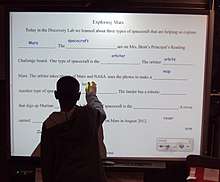Cloze test

A cloze test (also cloze deletion test) is an exercise, test, or assessment consisting of a portion of language with certain items, words, or signs removed (cloze text), where the participant is asked to replace the missing language item. Cloze tests require the ability to understand context and vocabulary in order to identify the correct language or part of speech that belongs in the deleted passages. This exercise is commonly administered for the assessment of native and second language learning and instruction.
The word cloze is derived from closure in Gestalt theory. The exercise was first described by W.L. Taylor in 1953.[1]
Task design
Words may be deleted from the text in question either mechanically (every nth word) or selectively, depending on exactly what aspect it is intended to test for. The methodology is the subject of an extensive academic literature;[2] nonetheless, teachers commonly devise ad hoc tests.
Example
A language teacher may give the following passage to students:
Today, I went to the ________ and bought some milk and eggs. I knew it was going to rain, but I forgot to take my ________, and ended up getting wet on the way.
Students would then be required to fill in the blanks with words that would best complete the passage. Context in language and content terms is essential in most, if not all, cloze tests. The first blank is preceded by "the"; therefore, a noun, an adjective or an adverb must follow. However, a conjunction follows the blank; the sentence would not be grammatically correct if anything other than a noun were in the blank. The words "milk and eggs" are important for deciding which noun to put in the blank; "supermarket" is a possible answer; depending on the student, however, the first blank could be store, supermarket, shop, shops, market, or grocer while umbrella, brolly or raincoat fit the second.
Assessment
The definition of success in a given cloze test varies, depending on the broader goals behind the exercise. Assessment may depend on whether the exercise is objective (i.e. students are given a list of words to use in a cloze) or subjective (i.e. students are to fill in a cloze with words that would make a given sentence grammatically correct).
I saw a man lay his jacket on a puddle for a woman crossing the street. I thought that was very ______.
Given the above passage, students' answers may then vary depending on their vocabulary skills and their personal opinions. However, the placement of the blank at the end of the sentence restricts the possible words that may complete the sentence; following an adverb and finishing the sentence, the word is most likely an adjective. Romantic, chivalrous or gallant may, for example, occupy the blank, as well as foolish or cheesy. Using those answers, a teacher may ask students to reflect on the opinions drawn from the given cloze.
Recent research using eye-tracking has posited that cloze/gapfill items where a selection of words are given as options may be testing different kinds of reading skills depending on the language abilities of the participants taking the test.[3] Lower ability test takers are suggested to be more likely to be concentrating on the information contained in the words immediately surrounding the gap, while higher ability test takers are thought to be able to use more global information in their selection of a word to fit the gap.
Implementation
In addition to use in testing, cloze deletion can be used in learning, particularly language learning, but also learning facts. This may be done manually – for example, by covering sections of a text with paper, or highlighting sections of text with a highlighter, then covering the line with a colored ruler in the complementary color (say, a red ruler for green highlighter) so the highlighted text disappears; this is popular in Japan, for instance. Cloze deletion can also be used as part of spaced repetition software, for example the SuperMemo and Anki applications feature semi-automated creation of cloze tests.
Cloze deletion can also be applied to a graphic organizer, wherein a diagram, map, grid, or image is presented and contextual clues must be used to fill in some labels.[4]
See also
References
- ↑ Taylor, W. L. (1953). "Cloze procedure: A new tool for measuring readability". Journalism Quarterly. 30: 415–433.
- ↑ Sachs, J.; Tung, P.; Lam, R. (Spring 1977). "How to Construct a Cloze Test: Lessons from Testing Measurement Theory Models". Perspectives. City University of Hong Kong. 9.
- ↑ McCray, Gareth; Brunfaut, Tineke (November 2016). "Investigating the Construct Measured by Banked Gap-fill Items: Evidence from Eye-tracking". Language Testing. doi:10.1177/0265532216677105.
- ↑ Robinson, M. E. (1 January 1974). "Cloze Procedure and Spatial Comprehension Tests". Area. 6 (2): 137–142. JSTOR 20000851.
Further reading
- Hanzeli, Victor E. (May 1977). "The Effectiveness of Cloze Tests in Measuring the Competence of Students of French in an Academic Setting". The French Review. 50 (6): 865–874. JSTOR 389444.
- McCray, Gareth; Brunfaut, Tineke (November 2016). "Investigating the Construct Measured by Banked Gap-fill Items: Evidence from Eye-tracking". Language Testing. doi:10.1177/0265532216677105.
External links
- Clozemaster, Website and app which provides extensive cloze-based tests to build comprehension and fluency in multiple languages.
- Cloze test, English grammar exercise from EnglishLearner.com
- Clozeline, Cloze activities with songs for Spanish class
- Online Cloze Test Creator, LearnClick.com
- VLC: Cloze Test Reading Exercises at the Wayback Machine (archived 2 November 2010)
- Cloze Test, bankersdaily.in
- Tips on solving Cloze Test, Tips on solving Cloze Test from LearningPundits.com
- Cloze your books!, Enter your own text to create a total cloze at GuruEAP.com